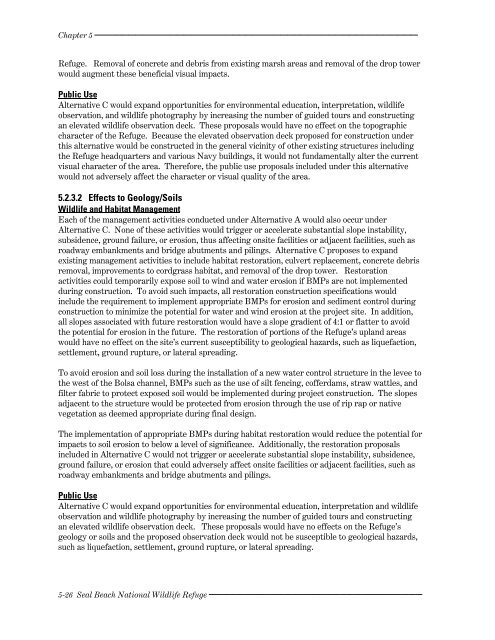Chapters 1 - U.S. Fish and Wildlife Service
Chapters 1 - U.S. Fish and Wildlife Service
Chapters 1 - U.S. Fish and Wildlife Service
You also want an ePaper? Increase the reach of your titles
YUMPU automatically turns print PDFs into web optimized ePapers that Google loves.
Chapter 5 <br />
Refuge. Removal of concrete <strong>and</strong> debris from existing marsh areas <strong>and</strong> removal of the drop tower<br />
would augment these beneficial visual impacts.<br />
Public Use<br />
Alternative C would exp<strong>and</strong> opportunities for environmental education, interpretation, wildlife<br />
observation, <strong>and</strong> wildlife photography by increasing the number of guided tours <strong>and</strong> constructing<br />
an elevated wildlife observation deck. These proposals would have no effect on the topographic<br />
character of the Refuge. Because the elevated observation deck proposed for construction under<br />
this alternative would be constructed in the general vicinity of other existing structures including<br />
the Refuge headquarters <strong>and</strong> various Navy buildings, it would not fundamentally alter the current<br />
visual character of the area. Therefore, the public use proposals included under this alternative<br />
would not adversely affect the character or visual quality of the area.<br />
5.2.3.2 Effects to Geology/Soils<br />
<strong>Wildlife</strong> <strong>and</strong> Habitat Management<br />
Each of the management activities conducted under Alternative A would also occur under<br />
Alternative C. None of these activities would trigger or accelerate substantial slope instability,<br />
subsidence, ground failure, or erosion, thus affecting onsite facilities or adjacent facilities, such as<br />
roadway embankments <strong>and</strong> bridge abutments <strong>and</strong> pilings. Alternative C proposes to exp<strong>and</strong><br />
existing management activities to include habitat restoration, culvert replacement, concrete debris<br />
removal, improvements to cordgrass habitat, <strong>and</strong> removal of the drop tower. Restoration<br />
activities could temporarily expose soil to wind <strong>and</strong> water erosion if BMPs are not implemented<br />
during construction. To avoid such impacts, all restoration construction specifications would<br />
include the requirement to implement appropriate BMPs for erosion <strong>and</strong> sediment control during<br />
construction to minimize the potential for water <strong>and</strong> wind erosion at the project site. In addition,<br />
all slopes associated with future restoration would have a slope gradient of 4:1 or flatter to avoid<br />
the potential for erosion in the future. The restoration of portions of the Refuge’s upl<strong>and</strong> areas<br />
would have no effect on the site’s current susceptibility to geological hazards, such as liquefaction,<br />
settlement, ground rupture, or lateral spreading.<br />
To avoid erosion <strong>and</strong> soil loss during the installation of a new water control structure in the levee to<br />
the west of the Bolsa channel, BMPs such as the use of silt fencing, cofferdams, straw wattles, <strong>and</strong><br />
filter fabric to protect exposed soil would be implemented during project construction. The slopes<br />
adjacent to the structure would be protected from erosion through the use of rip rap or native<br />
vegetation as deemed appropriate during final design.<br />
The implementation of appropriate BMPs during habitat restoration would reduce the potential for<br />
impacts to soil erosion to below a level of significance. Additionally, the restoration proposals<br />
included in Alternative C would not trigger or accelerate substantial slope instability, subsidence,<br />
ground failure, or erosion that could adversely affect onsite facilities or adjacent facilities, such as<br />
roadway embankments <strong>and</strong> bridge abutments <strong>and</strong> pilings.<br />
Public Use<br />
Alternative C would exp<strong>and</strong> opportunities for environmental education, interpretation <strong>and</strong> wildlife<br />
observation <strong>and</strong> wildlife photography by increasing the number of guided tours <strong>and</strong> constructing<br />
an elevated wildlife observation deck. These proposals would have no effects on the Refuge’s<br />
geology or soils <strong>and</strong> the proposed observation deck would not be susceptible to geological hazards,<br />
such as liquefaction, settlement, ground rupture, or lateral spreading.<br />
5-26 Seal Beach National <strong>Wildlife</strong> Refuge

















